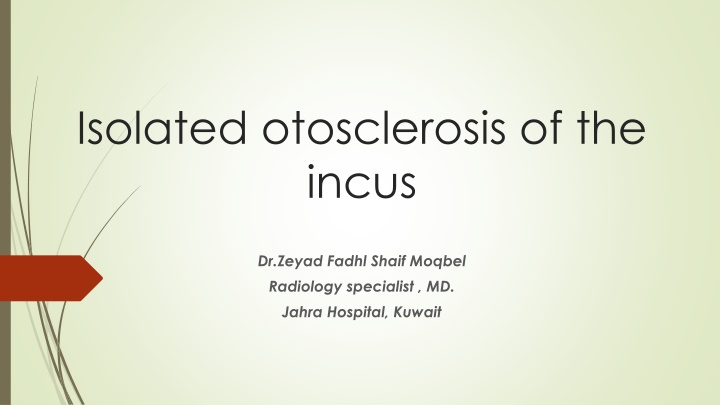
Rare Case of Isolated Otosclerosis of the Incus in a 50-Year-Old Woman
Discover a unique case of isolated otosclerosis localized to the incus in a 50-year-old woman presenting with progressive right-sided conductive hearing loss. Imaging features, treatment plan, and CT findings are discussed emphasizing the importance of accurate diagnosis and potential surgical management.
Download Presentation

Please find below an Image/Link to download the presentation.
The content on the website is provided AS IS for your information and personal use only. It may not be sold, licensed, or shared on other websites without obtaining consent from the author. If you encounter any issues during the download, it is possible that the publisher has removed the file from their server.
You are allowed to download the files provided on this website for personal or commercial use, subject to the condition that they are used lawfully. All files are the property of their respective owners.
The content on the website is provided AS IS for your information and personal use only. It may not be sold, licensed, or shared on other websites without obtaining consent from the author.
E N D
Presentation Transcript
Isolated otosclerosis of the incus Dr.Zeyad Fadhl Shaif Moqbel Radiology specialist , MD. Jahra Hospital, Kuwait
Case synopsis Otosclerosis is a primary disease of the bony labyrinth and stapes, typically leading to progressive conductive and sensorineural hearing impairment. Otosclerotic involvement of the ossicles beyond the stapes footplate is exceedingly rare. We present a case of a 50 year-old woman with progressive right-sided conductive hearing loss. The patient reported a gradual decline in hearing over several years without associated tinnitus or vertigo. Otoscopic examination was unremarkable, with a normal-appearing tympanic membrane. Audiometry confirmed conductive hearing loss. Imaging Features: CT Temporal Bone: Revealed focal lucency involving the body and short crus of the incus, suggestive of otospongiotic focus. There was no evidence of soft tissue opacification in the middle ear, nor erosive changes in the ossicular chain. The stapes footplate and malleus were normal. MRI Temporal Bone: Showed no significant abnormalities. Treatment Plan :Surgical management was recommended, surgical excision of the affected incus with ossicular chain reconstruction and prosthesis replacement. However, the patient declined surgical intervention. Final Diagnosis: Isolated Otosclerosis of the Incus. Conclusion : This case illustrates a rare form of otosclerosis localized to the incus, emphasizing the role of imaging in diagnosis.
CT FINDINGS:- Axial CT Left temporal bone Normal density of the incus Axial CT Right temporal bone: Decreased bone density of the incus of the right ear (arrow) Axial and coronal CT cuts through the temporal bone ( arrow) revealed reduced bone density of the right incus as compared to the left side.
Companion cases from the literature A 44-year-old Korean woman presented with a 5-year history of slow, progressive hearing loss in her right ear.A CT of the temporal bone revealing lucent lesion of the incus. 61-year-old woman with a progressive hearing loss on her left ear and a CT of the temporal bone revealing an expansible lucent lesion of the incus. Source: Kim KW, Jun HS, Im GJ, et al. Isolated otosclerosis of the incus in a Korean woman. Auris Nasus Larynx. 2011;38(5):654-656. doi:10.1016/j.anl.2010.12.015. Source: Escada PA, Capucho C, Chor o M, da Silva JF. Otosclerosis of the incus. Otol Neurotol. 2007;28(3):301-303. doi:10.1097/01.mao.0000265186.37592.78.
References 1. Kim KW, Jun HS, Im GJ, et al. Isolated otosclerosis of the incus in a Korean woman. Auris Nasus Larynx. 2011;38(5):654-656. doi:10.1016/j.anl.2010.12.015. 2. Escada PA, Capucho C, Chor o M, da Silva JF. Otosclerosis of the incus. Otol Neurotol. 2007;28(3):301-303. doi:10.1097/01.mao.0000265186.37592.78. PMID: 17414034.
